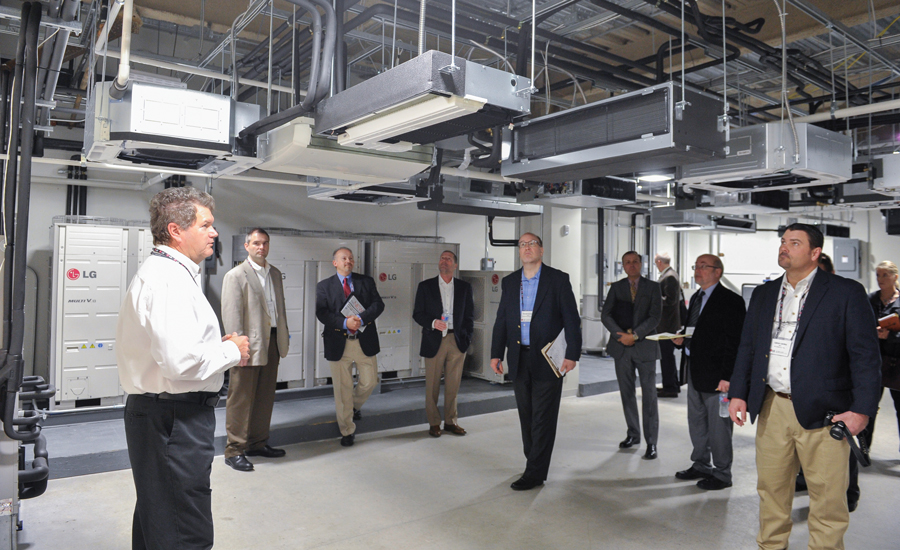Continual training is a necessity within the HVAC industry in order to keep up with ever-changing technology. Many manufacturers have developed their own programs in order to train and educate contractors and technicians on their products. And, within those programs, many manufacturers place a high priority on safety education.
LG Electronics has four training academies across the U.S., including its new Learning Academy inside of its new headquarters in Alpharetta, Georgia, which opened last month.
“It has examples of our current products up and running so they can actually see it, hear it, and play with it,” said Don Fort, manager, national training and tech support, LG Electronics.
When it comes to certain components that are potentially dangerous within LG’s training modules, the manufacturer touches on common safety practices.
“The folks that come through our training typically have industry experience,” Fort said. “We stress the importance of safety. For example, today’s advanced refrigerants operate under much higher pressures and are often more dangerous. So, when troubleshooting advanced compressor technology, refrigeration, and electrical components, we make a point of making sure they know what the dangers are when the protective covers come off. Since you never know what can happen, that’s the best way to avoid serious injury. We also recommend wearing proper PPE [personal protective equipment] for the task at hand. That way, they’re working safely.”
Fort described the integration of safety education into LG’s training as nice reminders as contractors and technicians learn about the manufacturer’s products.
“None of the things we talk about should be new to the folks who attend our training,” Fort noted. “They’re just nice reminders because sometimes people get complacent, especially if they’ve been doing this for a long time and that can be dangerous. It is important for our training to highlight the risks and probable outcomes, as we want people to be safe. We do address the things we know can be potential issues in terms of safety when we’re facilitating training for contractors during our normal sessions.”
Mitsubishi Electric US Cooling and Heating Division also offers a vast array of technical training and professional development courses. In addition to its corporate training facility in Suwanee, Georgia, the manufacturer operates six regional training facilities in Boston; Houston; Orlando, Florida; Chicago; Hebron, Kentucky; and Cypress, California.
“A core principle of our technical courses is ensuring our instructors are aware of Mitsubishi Electric’s specific safety guidelines,” said Carol Wilson, organizational development and training manager, Mitsubishi Electric US Cooling and Heating Division. “Our focus on safety education enables us to create an environment that places the wellbeing of our customers and employees at the forefront of all technical courses where equipment is used for hands-on training. We also stress the importance of following local and state codes for installing equipment and the proper handling of wiring and refrigerant.”
Additionally, Mitsubishi Electric believes any HVAC professional interaction with its products must be done safely, Wilson noted. “Whether it is with our residential or commercial systems, safety is encouraged at all times. Safety education is important to ensure our course participants are using safety practices while installing or working on our equipment.”
LIFELONG LEARNING
At Johnson Controls Inc., continuous improvement and education is an expectation in both internal and external training, according to Darryl Hill, vice president of health and safety.
“Operating a safe workplace is one of nine principles of the Johnson Controls Manufacturing System, or JCMS, as we refer to it,” Hill said. “Training courses are identified based on three areas: risks at the site, regulatory requirements, and lessons learned from our incident investigations. These three key areas dictate not only what training courses need to be developed, but how many are actually assigned to the individual employee for completion.”
Additionally, Johnson Controls’ branch network has more than 50 training modules covering different topics specific to safety, according to Kristy Nelson, director, safety and industrial hygiene, SSNA. “Our training modules are developed internally and feature our own employees, and their work experiences show the hazards they face in their work environments. It’s very practical. We use the video clips and pictures of employees on the job. The modules are then facilitated by our leaders, who ensure everybody is engaged and getting a consistent message.
“Safety training must provide the skills employees need to do the work, not just inform them about the hazard,” Nelson continued. “In our work setting, our training focuses on how we expect employees to prevent injuries. Safety is a culture that is reinforced at the local level. Training and safety education is not just something they have to take part in; it’s something we’re trying to get them to want to do. They should want to be safe. That’s part of the reason we put so much emphasis on training and education.”
Safety is also a focus for Johnson Controls’ external training programs, Hill noted.
“As we were developing our maturity model, there was a focused effort to make sure a contractor training interface was included,” he said. “We know you have to include contractors and consider them in your training, even from a regulatory requirement standpoint. We recognize and consider them [contractors] as employees in many respects in terms of inclusion within training. Contractor safety and management is a key aspect of our training.”
Publication date: 12/21/2015
Want more HVAC industry news and information? Join The NEWS on Facebook, Twitter, and LinkedIn today!











